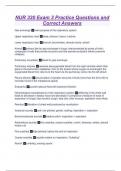NUR 330 Exam 3 Practice Questions and
Correct Answers
Gas exchange ✅main purpose of the respiratory system
Upper respiratory tract ✅nose, pharynx, larynx, trachea
Lower respiratory tract ✅bronchi, bronchioles, alveolar ducts, alveoli
Alveoli ✅primary site for gas exchange in lungs; interconnected by pores of kohn;
composed of cells that provide structure and that secrete surfactant (which prevents
collapse)
Pulmonary circulation ✅blood for gas exchange
Pulmonary arteries ✅receives deoxygenated blood from the right ventricle which then
goes to the pulmonary capillaries, then to the alveoli where oxygen is exchanged; the
oxygenated blood then returns to the heart via the pulmonary veins into the left atrium
Pleural effusion ✅accumulation of greater amounts of fluid (more than the 20 to 25 ml
normally found in the intrapleural space)
Empyema ✅purulent pleural fluid with bacterial infection
Gerontological considerations of the respiratory system ✅stiffening of the chest wall
leads to decrease in elastic recoil and decrease in compliance (measure of ease of
expansion of lungs); less forceful cough, less cilia, drier mucous, aspiration more likely
Remitus ✅vibration of chest wall produced by vocalization
Vesicular sounds ✅soft, low pitched, gentle, rustling; inspiration > expiration
Bronchovesicular sounds ✅medium pitch; inspiration = expiration
Adventitious sounds ✅fine crackles, coarse crackles, ronchi, wheezes, stridor, pleural
friction rub
Fine crackles ✅high pitched, before the end of inspiration
Coarse crackles ✅usually evident on inspiration, "bubbling"
Ronchi ✅rumbling, snoring sound
,Wheezes ✅indicate bronchospasm
Stridor ✅croup, epiglottis, vocal cord edema
Pleural friction rub ✅sounds like leather rubbing together
A patient comes into the ed with a severe exacerbation of asthma. What is your priority?
What are you going to delay until later? ✅priority: administer oxygen and provide a
short acting bronchodilator
Later: history and physical
Polycythemia ✅over-production of red blood cells; body reproduces rbcs to attempt to
compensate for hypoxia
Cor pulmonale ✅enlargement/failure of the right ventricle due to vasoconstriction;
blood vessels in lung constrict causing high bp and prolonged exhalation
Inhalation devices ✅metered dose inhaler, dry powder inhalers, nebulizers
Atherosclerosis ✅deposits of fat build up in the arteries that harden with age
Modifiable risk factors of atherosclerosis ✅obesity, tobacco use, elevated serum lipids,
physical inactivity, hypertension, diabetes, substance abuse, metabolic syndrome,
psychological status
Non-modifiable risk factors of atherosclerosis ✅age, ethnicity (more common in
caucasians), gender (more common in men until age 65 and then the risk becomes the
same), family history
Fatty streak of atherosclerosis ✅lipids accumulate and migrate into smooth muscle
cells; yellow tinge
Fibrous plaque of atherosclerosis ✅collagen covers fatty streak; vessel lumen is
narrowed and blood flow reduced; greying/whitening appearance
Complicated lesion of atherosclerosis ✅plaque rupture; thrombus formation; further
narrowing or total occlusion of artery
Collateral circulation ✅body creates new blood vessels to bypass the imminent
occlusion (inherited predisposition, presence of chronic ischemia)
Hypertension ✅bp greater than or equal to 140/90
, Current use of an anti-hypertensive medication
Pathophysiology of hypertension ✅occurs with any increase in cardiac output (co) or
systemic vascular resistance (svr)
Water and sodium retention, altered raas (high plasma renin activity), stress and
increased sympathetic nervous system activity, insulin resistance and hyperinsulinemia,
endothelium dysfunction
Etiology of hypertension ✅primary: elevated bp without an identified cause
Contributing factors: increased sns activity, increased sodium-retaining hormones and
vasoconstrictors, increased sodium intake, diabetes, greater than ideal body weight,
excessive alcohol intake
Secondary: elevated bp with a specific cause that can be identified and corrected
Contributing factors: coarctation of aorta, renal disease, endocrine disorders, neurologic
disorders, cirrhosis, sleep apnea
Risk factors for hypertension ✅age, alcohol, cigarette smoking, diabetes, elevated
serum lipids, excess dietary sodium, gender, family history, obesity, ethnicity, sedentary
lifestyle, socioeconomic status, stress
Diagnostic & laboratory tests & findings ✅history and physical examinations
Bilateral bp measurement (use arm with higher reading for subsequent measurements)
Urinalysis, creatinine clearance, serum electrolytes, glucose, bun and serum creatinine,
serum lipid profile, ecg, echocardiogram
"white coat" phenomenon may precipitate the need for ambulatory blood pressure
monitoring (abpm)
*bp is highest in early morning, lowest at night*
Clinical manifestations of hypertension ✅symptoms are often secondary to target
organ disease and can include: fatigue, reduced activity tolerance, dizziness,
palpitations, angina, dyspnea
Complications of hypertension ✅target organ diseases occur most frequently in the
heart, brain, peripheral vasculature, kidney, eyes
Coronary artery disease, heart failure, left ventricular hypertrophy, cerebrovascular
disease (stroke), peripheral vascular disease, nephrosclerosis, retinal damage




